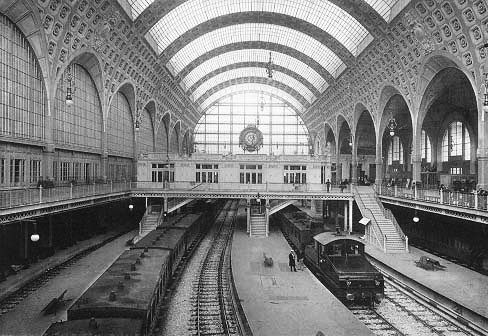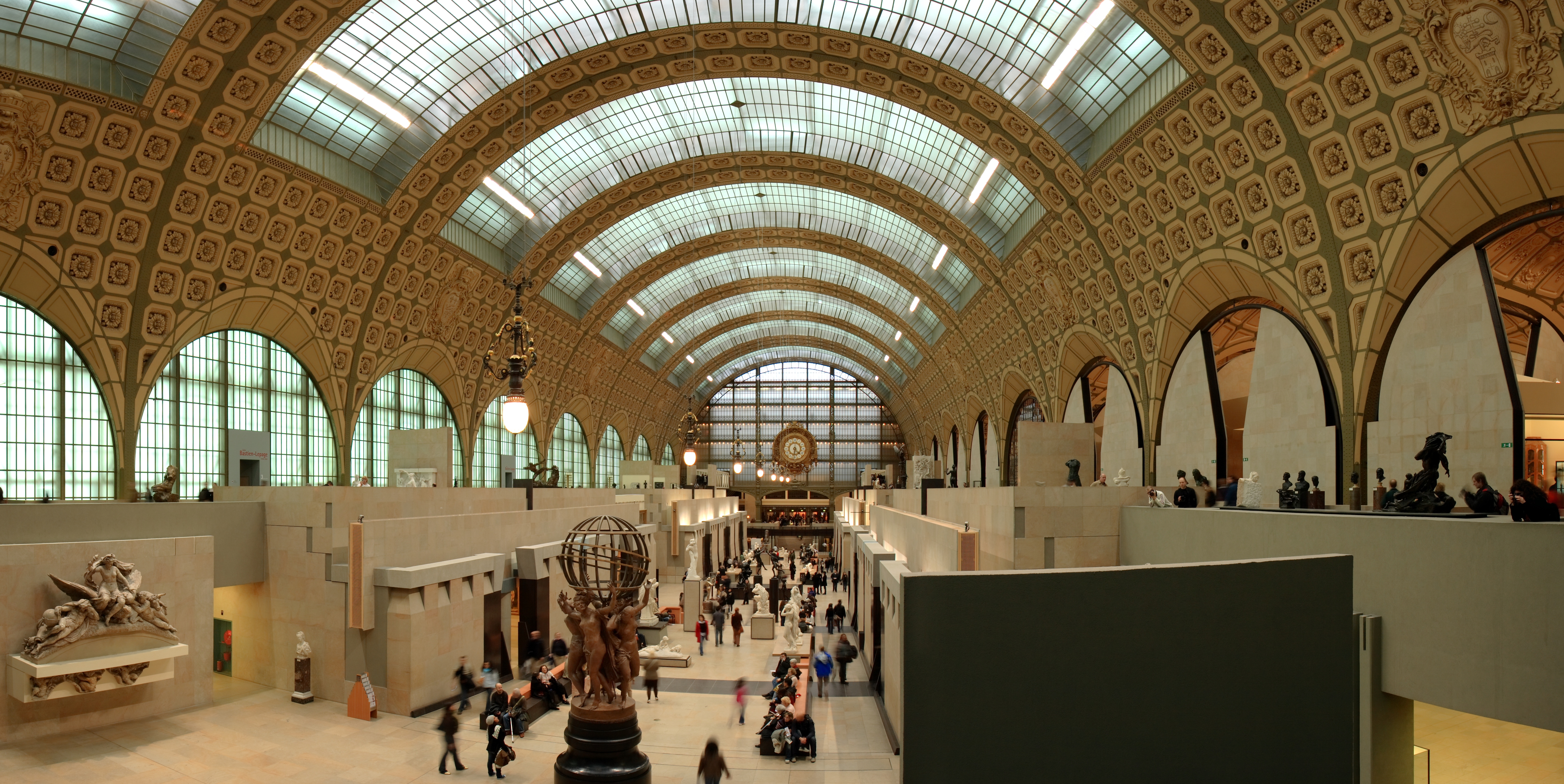Gare Du Quai D'Orsay on:
[Wikipedia]
[Google]
[Amazon]
Gare d'Orsay is a former Paris railway station and hotel, built in 1900 to designs by Victor Laloux, Lucien Magne and Émile Bénard; it served as a terminus for the Chemin de Fer de Paris à Orléans (Paris–Orléans Railway). It was the first electrified urban terminal station in the world, opened 28 May 1900, in time for the 1900 Exposition Universelle. After closure as a station, it reopened in December 1986 as the
 The site was purchased by the Compagnie Paris-Orléans, which erected the monumental terminus station for its railways to southwestern France. The station had electrified tracks, modelled on the Baltimore Belt Line electrified railway which had been completed in 1895. The station was constructed in Beaux-Arts style and the western and southern sides of the building included the 370-room Hotel Palais d'Orsay.
By 1939 the station's short platforms had become unsuitable for the longer trains that had come to be used for mainline services, and the Gare d'Orsay was closed to long-distance traffic, though some suburban trains of the
The site was purchased by the Compagnie Paris-Orléans, which erected the monumental terminus station for its railways to southwestern France. The station had electrified tracks, modelled on the Baltimore Belt Line electrified railway which had been completed in 1895. The station was constructed in Beaux-Arts style and the western and southern sides of the building included the 370-room Hotel Palais d'Orsay.
By 1939 the station's short platforms had become unsuitable for the longer trains that had come to be used for mainline services, and the Gare d'Orsay was closed to long-distance traffic, though some suburban trains of the
 In 1977, the French Government decided to convert the station to a museum. The building was listed as a historical monument in 1978 and reopened as the
In 1977, the French Government decided to convert the station to a museum. The building was listed as a historical monument in 1978 and reopened as the
Satellite image from Google Maps
{{DEFAULTSORT:Orsay Railway termini in Paris Defunct railway stations in Paris History of Paris Hotel buildings completed in 1900 Railway stations in France opened in 1900 Railway hotels Beaux-Arts architecture in France Historicist architecture in France Buildings and structures in the 7th arrondissement of Paris
Musée d'Orsay
The Musée d'Orsay ( , , ) ( en, Orsay Museum) is a museum in Paris, France, on the Left Bank of the Seine. It is housed in the former Gare d'Orsay, a Beaux-Arts railway station built between 1898 and 1900. The museum holds mainly French art ...
, an art museum. The museum is currently served by the RER station of the same name.
History
The site was occupied by the , intended for the Council of State. It was begun in 1810 but not completed until 1840, when its ground floor was occupied by the Council. In 1842 the Cour des Comptes was housed in the first floor. After the fall of the French Second Empire in 1870, the Paris Commune briefly took power from March through May 1871. The archives, library and works of art were removed toPalace of Versailles
The Palace of Versailles ( ; french: Château de Versailles ) is a former royal residence built by King Louis XIV located in Versailles, Yvelines, Versailles, about west of Paris, France. The palace is owned by the French Republic and since 19 ...
and eventually both the ''Conseil'' and the ''Cour des Comptes'' were rehoused in the Palais-Royal
The Palais-Royal () is a former royal palace located in the 1st arrondissement of Paris, France. The screened entrance court faces the Place du Palais-Royal, opposite the Louvre. Originally called the Palais-Cardinal, it was built for Cardinal ...
.
The largely empty Palais d'Orsay was burned by the soldiers of the Paris Commune, along with the Tuileries Palace and several other public buildings associated with Napoleon III, on the night of 23–24 May 1871, an event which was described by Émile Zola.
 The site was purchased by the Compagnie Paris-Orléans, which erected the monumental terminus station for its railways to southwestern France. The station had electrified tracks, modelled on the Baltimore Belt Line electrified railway which had been completed in 1895. The station was constructed in Beaux-Arts style and the western and southern sides of the building included the 370-room Hotel Palais d'Orsay.
By 1939 the station's short platforms had become unsuitable for the longer trains that had come to be used for mainline services, and the Gare d'Orsay was closed to long-distance traffic, though some suburban trains of the
The site was purchased by the Compagnie Paris-Orléans, which erected the monumental terminus station for its railways to southwestern France. The station had electrified tracks, modelled on the Baltimore Belt Line electrified railway which had been completed in 1895. The station was constructed in Beaux-Arts style and the western and southern sides of the building included the 370-room Hotel Palais d'Orsay.
By 1939 the station's short platforms had become unsuitable for the longer trains that had come to be used for mainline services, and the Gare d'Orsay was closed to long-distance traffic, though some suburban trains of the SNCF
The Société nationale des chemins de fer français (; abbreviated as SNCF ; French for "National society of French railroads") is France's national state-owned railway company. Founded in 1938, it operates the country's national rail traffi ...
continue to use its lower levels to this day. The Hotel Palais d'Orsay closed at the beginning of 1973.
The former station was used as a collection point for the dispatch of parcels to prisoners of war
A prisoner of war (POW) is a person who is held Captivity, captive by a belligerent power during or immediately after an armed conflict. The earliest recorded usage of the phrase "prisoner of war" dates back to 1610.
Belligerents hold priso ...
during the Second World War, and after the war as a reception centre for liberated prisoners on their return; a plaque on the side of the building facing the River Seine commemorates this latter use.
The structure served as the setting for several films, including Orson Welles' version of Franz Kafka's '' The Trial'', and is a central location in Bernardo Bertolucci's '' The Conformist''. General Charles de Gaulle
Charles André Joseph Marie de Gaulle (; ; (commonly abbreviated as CDG) 22 November 18909 November 1970) was a French army officer and statesman who led Free France against Nazi Germany in World War II and chaired the Provisional Government ...
held a press conference in the ballroom of the Hotel Palais d'Orsay on 19 May 1958 at which he announced his "availability to serve his country", ushering in the end of the French Fourth Republic.
As well, it was the inspiration for the larger Penn Station in New York City when Alexander Cassatt, president of the Pennsylvania Railroad
The Pennsylvania Railroad (reporting mark PRR), legal name The Pennsylvania Railroad Company also known as the "Pennsy", was an American Class I railroad that was established in 1846 and headquartered in Philadelphia, Pennsylvania. It was named ...
, traveled on his annual trip to Europe in 1901.
Museum
 In 1977, the French Government decided to convert the station to a museum. The building was listed as a historical monument in 1978 and reopened as the
In 1977, the French Government decided to convert the station to a museum. The building was listed as a historical monument in 1978 and reopened as the Musée d'Orsay
The Musée d'Orsay ( , , ) ( en, Orsay Museum) is a museum in Paris, France, on the Left Bank of the Seine. It is housed in the former Gare d'Orsay, a Beaux-Arts railway station built between 1898 and 1900. The museum holds mainly French art ...
in December 1986. The chief architect for the conversion was the Italian Gae Aulenti. There is a huge clock which still works in the main terminal housing the museum.
References
External links
Satellite image from Google Maps
{{DEFAULTSORT:Orsay Railway termini in Paris Defunct railway stations in Paris History of Paris Hotel buildings completed in 1900 Railway stations in France opened in 1900 Railway hotels Beaux-Arts architecture in France Historicist architecture in France Buildings and structures in the 7th arrondissement of Paris